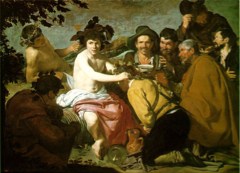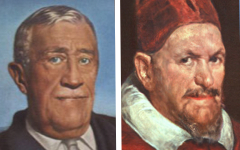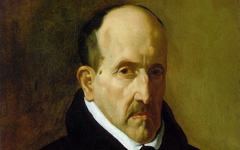Velazquez’s Portrait of Infante Felipe Prospero (1659)

Velazquez, Prince Baltasar Carlos and Dwarf (1632) oil on canvas. Kunsthistorisches Museum, Vienna
Click image to enlarge.
Thirty years before portraying Felipe Prospero, Velazquez made a portrait of an earlier heir to the Spanish throne, Baltasar Carlos (left). Let's look at that first. Some have observed that Carlos' face and stiff pose contrast with the twisting torso and shadowed features of the dwarf and that the rattle and apple resemble an orb and scepter. With his distant gaze Prince Carlos also seems unaware of the female dwarf because he, the prince, is "painted" while she, representing the craftsman-painter, stands in front of her "canvas" with objects vaguely resembling a brush and palette. Besides, the carpet slopes upwards as though it is part of the prince's space (in other words, the upright "painted canvas") and not of the dwarf's in front of it.
Click next thumbnail to continue
After the deaths of his queen and heir-to-the-throne, the king remarried and produced a new heir, Felipe Prospero. In this portrait the child adopts the pose of the late Baltasar Carlos, with the same extended arm. The latter conveys regal bearing but is also similar to how a painter stretches his own arm towards a canvas. Velazquez had used the gesture for that purpose in his earlier portrait of the Count-Duke of Olivares. As with Baltasar Carlos, the new prince's stiff pose suggests that he is "the painting" in the painting. The more life-like dog, on the other hand, is the artist, once again in front of "his painting" and near the left-hand edge.
Click next thumbnail to continue

Left: Detail of Velazquez's Portrait of Felipe Prospero (1659)
Right: Self-portrait detail of Las Meninas (1656)
Click image to enlarge.
Compare the dog's pose to the figure of Velazquez in Las Meninas and note that the texture of its furry paw recalls the hairs of a brush. Their heads lean at the same angle while the studs on the edges of the chair resemble those on the stretchers edging a canvas. Also, the dog's paw passes through the canvas-shaped rectangular space beneath the chair's arm, faintly echoing the extended arm of the prince (not illustrated here) above.
Click next thumbnail to continue
To eliminate any doubt that the dog represents the artist, Velazquez curved its mouth into a "smile", the shape of his own moustache, a reference no writer has noted before. Whether or not dogs "smile" in this manner, the similarity can only be intentional because the odds of it ocurring accidentally would be infinitely greater.
See conclusion below
In both portraits Velazquez represents the artist-as-craftsman as dwarf or dog in the lower left quadrant and in the foreground. Meanwhile, he represents his soul's potential to become royal, symbolic of purity and inner knowledge, by portraying the real artist in a lowly state, as dog or dwarf. But, since every painter paints himself, he must also by the king-in-waiting behind. The dog depicts the world of the senses, the prince that of his soul. Once again we see inside the artist's mind where, in a mental image, his presence in the studio is fused with the painting-at-hand.
For an analysis of the earlier portrait of Baltasar Carlos, click here.
More Works by Velazquez
Notes:
1. Jonathan Brown, Velazquez: Painter and Courtier (Yale University Press) 1986, p.83
Original Publication Date on EPPH: 02 Mar 2012. | Updated: 0. © Simon Abrahams. Articles on this site are the copyright of Simon Abrahams. To use copyrighted material in print or other media for purposes beyond 'fair use', you must obtain permission from the copyright owner. Websites may link to this page without permission (please do) but may not reproduce the material on their own site without crediting Simon Abrahams and EPPH.





